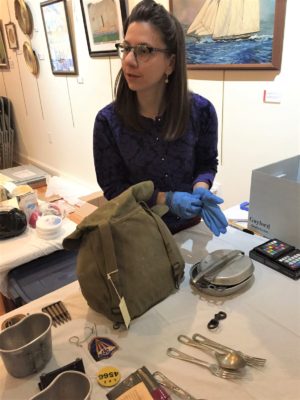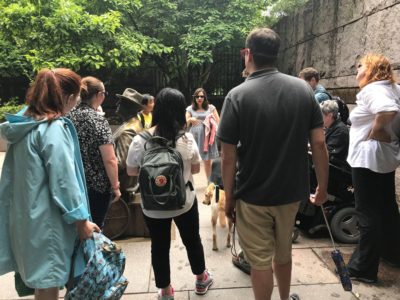Introducing Nicole Belolan
10 September 2018 – Nicole Belolan
Ask a Practitioner, methods, digital history, accessibility, collaboration, education, employment, NCPH

Nicole Belolan rehousing a World War II-era pack at the Milton Historical Society in Milton, Delaware, during SWAT 2015. Photo credit: Nicole Belolan
Editors’ Note: We are excited to introduce Nicole Belolan, the newest member of the NCPH, TPH, History@Work, and MARCH team to our readers. Please enjoy the opportunity to learn more about her through this interview conducted by the NCPH staff.
What does “public history” mean to you?
I think of public history as any history that is not aimed at or made exclusively with (other) academics or historians. It encompasses everything from teaching in the classroom to curating exhibitions in museums or libraries to adapting history for the stage or screen. There are probably as many ways to define public history as there are people who practice public history, so I won’t do too much more defining and just add that some of the core values I hold as a public historian include accessibility, inclusion, advocacy, transparency, professionalism and, of course, collaboration. I think everyone has something to bring to the table when it comes to history.
Can you tell us a bit about your path toward public history?
My path toward this field started with things. I have very early, vivid memories of roaming open storage in the Metropolitan Museum of Art’s American Wing and digging through dusty trinkets at antique malls with my family. So for a long time, I have been transfixed by real pieces of the past. I continue to want to touch, feel, and experience the real thing or place whenever I have the chance! I think we all crave that visceral connection too, despite our society’s emphasis on the digital world and our field’s emphasis on digital outreach (no doubt an important part of our work, particularly because it makes the past more accessible to more people!).
Despite going to many museums and antique malls with my family as a kid, I did not realize public history was a career field until I attended an alumni panel in college and heard from someone about their successful museum education career. So, I majored in American Studies with emphases in history, literature, and museums and material culture. I met a professor who taught an undergraduate furniture and decorative arts class with his own antiques collection who also helped me set up museum internships.

Nicole talking about the history of wheelchairs at the Franklin Delano Roosevelt Memorial, National Park Service, in Washington, D.C., last summer, with colleagues from the NEH Summer Institute in Global Histories of Disability. Photo credit: Leah Richier.
This real-world experience paved the way for graduate work. I earned my MA from the Winterthur Program in American Material Culture at the University of Delaware. I worked at Winterthur in the curatorial department on grant-funded projects and decided I wanted to learn more about the material culture of physical disability in early America (which grew out of a few research projects). I pursued this project because I wanted to study things—crutches, wheelchairs, artificial limbs, etc.—in person and contribute to our public and scholarly understanding about what it was like to be disabled in early America. I did this through the PhD program in the History of American Civilization in the department of history at the University of Delaware, which attracts students who want to work in the academy and/or public history world. Most recently, I worked at Rowan University, Red Bank Battlefield Park in New Jersey, and at the Consortium for the History of Science, Technology, and Medicine in Philadelphia.
What does your new position entail?
My new position has a few components, all of which will inform each other. At MARCH, I administer and will teach in our Historic Preservation continuing education program (in partnership with the New Jersey Historic Trust), which offers courses on topics ranging from an introduction to the National Register to assessing how to finance a preservation project. Participants may take the courses as one-offs or pursue the certificate through Rutgers. MARCH courses serve broad constituencies. I look forward to building on and enhancing this program’s impact.
I also look forward to creating other professional development and service opportunities for students and folks in the field, perhaps modeled after the small museum inventory “SWAT” projects I was involved in through the University of Delaware’s Sustaining Places initiative. It is my experience that small, local, community-based museums need the most help and support these days when it comes to capacity building and advocacy. They also happen to be great learning laboratories for students and the communities they serve.
This position also includes a collaboration with NCPH’s The Public Historian, where I serve as co-editor. I also serve as NCPH’s digital media editor, working with colleagues at History@Work in particular. My main task is to liaise between the two publications and facilitate bringing them in conversation with each other while ensuring we’re relevant and responsive to our audience. I also get to recruit prospective writers and reviewers and work on day-to-day editing tasks.
Finally, I am also an ex-officio member of the NCPH board. Some of the field-wide concerns I’d like to bring more attention to include financial support of students’ graduate work and pay (especially at the entry level). I also think we need to do a better job as a field talking to students (especially undergraduate, non-history majors) and the public (government officials, non-profit board members, ordinary citizens, volunteers, etc.) about what it takes to run and sustain museums, historic sites, libraries, and archives, digital projects, archaeology digs and surveys and to keep historic structures standing and in good repair—and why it matters. This advocacy will strengthen our current and future community partnerships.
What are you most excited about in this new position?
I am excited about the fact that I get to work with local, regional, and national constituencies every day. At TPH, I hope we hear more from small-to-medium sized sites and institutions, sites that interpret eighteenth- and nineteenth-century history, and varied material from diverse institutions and project managers for the non-book (documentaries, exhibitions, digital projects, etc.) review section.
Similarly, when it comes to digital projects, on the H@W blog, I would love to hear more from practitioners about how they solved everyday problems where they work. I’d also like to think about assessing H@W’s accessibility as a web platform. As a historian of disability, I know the history of all this, but I am still learning the mechanics behind how to make something accessible. In the spirit of transparency, I think this is something we can blog about. Finally, we’ve already talked about some other projects in the works that will bridge print and digital content—such as a series of posts that build off the content in the most recent issue of TPH about black museums—so stayed tuned for that!
At MARCH, I am excited to learn from the public about their historic preservation needs, broadly defined. In so doing, I plan to work with them on building capacity at their institutions and in their communities. I also look forward to raising the profile of disability history and introducing budget-friendly tools for making history more accessible, both physically and programmatically, at the local and regional levels.
What new voices do you hope to invite into TPH and H@W?
With each of the projects we take on, I think it’s important to think about how to recruit more contributors who are more representative of the diversity of folks in the US and the field. I also think we can learn a lot from soliciting the perspectives of people who are not historians to provide interdisciplinary insight into whatever history is at hand. And finally, I think we need to look for ways to include non-traditional consumers of history into our conversations. These are exciting challenges not just for NCPH and MARCH but for the field as a whole.
~ Nicole Belolan is public historian in residence at the Mid-Atlantic Regional Center for the Humanities (MARCH) at Rutgers University-Camden, co-editor of The Public Historian, and digital media editor for the National Council on Public History.



